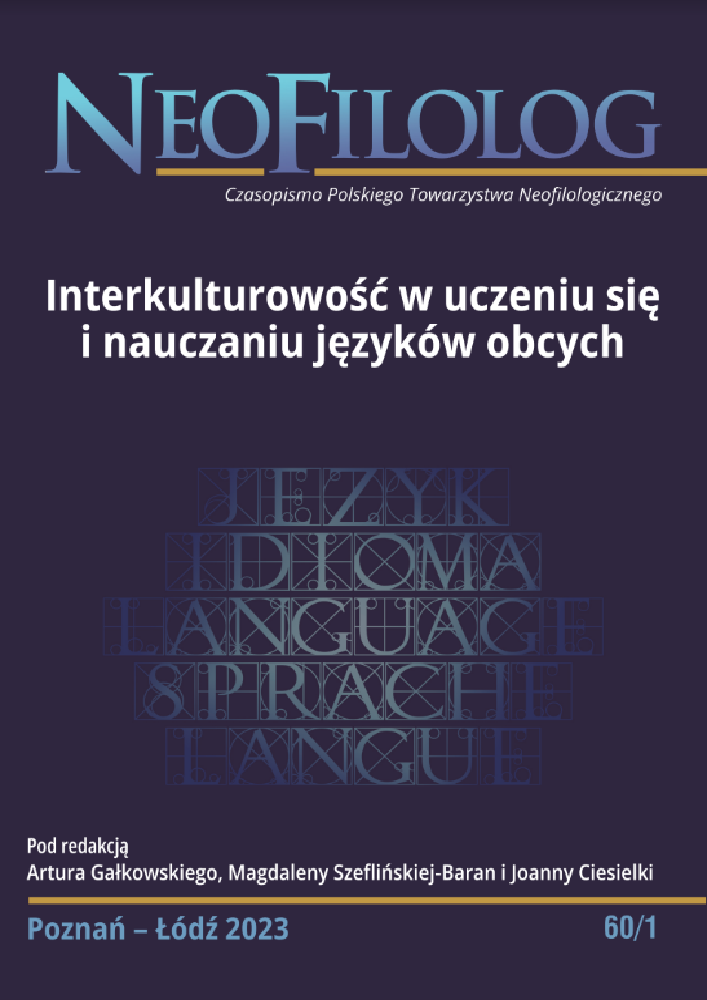Abstract
This study explores the link between language and culture in the context of translating specialist texts. The starting point is the assumption that each text contains a cultural element, even if it is “only” a professional text. The illustration of the theoretical considerations is a comparative analysis of translations (from French into Polish) of press articles in the field of economics. The analysis of selected press materials shows that their cultural value is not a peripheral phenomenon, but constitutes an important sense-creating element. In the process of their translation, the translator's tasks include not only changing the original linguistic structures, but also changing the cultural perspective embedded in the text. The carriers of the cultural point of view are both single lexical units, as well as linguistic constructions and complex conceptual networks. Based on the research, the authors conclude that it seems particularly important to sensitize students to respect the genre standards of the target language and to understand the need to reconceptualize the original conceptual metaphor and change the deictic perspective of the text.
References
Anusiewicz J., Nieckula F. (red.) (1992), Język a kultura, tom 5. Potoczność w języku i kulturze. Wrocław: Wydawnictwo Wiedza o Kulturze.
Barańczak S. (1992), Ocalone w tłumaczeniu: szkice o warsztacie tłumacza poezji z dodatkiem Małej antologii przekładów-problemów. Kraków: Wydawnictwo „a5”.
Bartmiński J. (red.) (1999), Językowy obraz świata. Lublin: Wydawnictwo UMCS.
Bartmiński J., Tokarski R. (1993), Definicja semantyczna: czego i dla kogo?, (w:) Bartmiński J., Tokarski R. (red.), O definicjach i definiowaniu. Lublin: Wydawnictwo UMCS, s. 47-61.
Bogdanowicz E. (2017), Konotacje nazw własnych (na materiale publicystyki prasowej). Białystok: Wydawnictwo Uniwersytetu w Białymstoku.
Hejwowski K. (2004), Kognitywno-komunikacyjna teoria przekładu. Warszawa: PWN.
Jakobson R. (1960), Poetyka w świetle językoznawstwa. „Pamiętnik Literacki”, nr 51/2, 1960, s. 431-473.
Lakoff G., Johnson M. (2010), Metafory w naszym życiu. Warszawa: Wydawnictwo Aletheia.
Lewandowska-Tomaszczyk B. (2010), Nowe spojrzenie na przekład: podobieństwo, granice ekwiwalencji i rekonceptualizacja. „Lingwistyka Stosowana”, nr 3, s. 9-31.
Marcjanik M. (2007), Grzeczność w komunikacji językowej. Warszawa: PWN.
Paprocka N. (2005), Problemy klasyfikacji błędów w przekładzie. Studenckie tłumaczenia tekstów użytkowych z francuskiego na polski, (w:) Piotrowska M. (red.), Język trzeciego tysiąclecia III. Konteksty przekładowe. Kraków: Tertium, s. 417-428.
Piotrowski S., Sadowska-Dobrowolska K. (2020), Tłumaczenie pisemne na język polski: o spójności tekstu docelowego. „Roczniki Humanistyczne”, t. LXVIII, s. 89-102. DOI: https://doi.org/10.18290/rh206810-7
Płużyczka M. (2010), Bezekwiwalentność a kontekst kulturowy, (w:) Grucza S., Marchwiński A., Płużyczka M. (red.), Translatoryka. Koncepcje – modele – analizy. Warszawa: Uniwersytet Warszawski, s. 387-399.
Shank R.C., Abelson R.P. (1977), Scripts, Plans, Goals and Understanding. An Inquiry Into Human Knowledge Structures. London: Routledge.
Tabakowska E. (2010), Wyznaczniki literackości w przekładzie tekstów „nieliterackich”, (w:) Grucza S., Marchwiński A., Płużyczka M. (red.), Translatoryka. Koncepcje – modele – analizy. Warszawa: Uniwersytet Warszawski, s. 144-155.
Tokarski R. (1988), Konotacja jako składnik treści słowa, (w:) Bartmiński J. (red.), Konotacja. Lublin: Wydawnictwo UMCS, s. 35-54.
Tokarski R. (2001), Słownictwo jako interpretacja świata, (w:) Bartmiński J. (red.), Współczesny język polski. Lublin: Wydawnictwo UMCS, s. 343-370.
Urbanek D. (2010), Tłumaczenie jako komunikacja interkulturowa, (w:) Grucza S., Marchwiński A., Płużyczka M. (red.), Translatoryka. Koncepcje – modele – analizy. Warszawa: Uniwersytet Warszawski, s. 156-163.
Walasek H. (2004), Polski język unijny (eurożargon) jako nowa odmiana języka polskiego, (w:) Dąbrowska A. (red.), Wrocławska dyskusja o języku polskim jako obcym. Wrocław: Wydawnictwo WTN, s. 263-268.
Wojtak M. (2004), Gatunki prasowe. Lublin: Wydawnictwo UMCS.
Zarzycka G. (2004), Linguakultura – czym jest, jak ją badać i „otwierać”?, (w:) Dąbrowska A. (red.), Wrocławska dyskusja o języku polskim jako obcym. Wrocław: Wydawnictwo WTN, s. 435-443.
License
Copyright (c) 2023 Piotrowski Sebastian, Katarzyna Sadowska-Dobrowolska

This work is licensed under a Creative Commons Attribution-NoDerivatives 4.0 International License.
Authors
Authors of texts accepted for publication in Neofilolog are required to complete, sign and return to the Editorial team’s office the Agreement for granting a royalty-free license to works with a commitment to grant a CC sub-license.
Under the agreement, the authors of the texts published in Neofilolog grant Adam Mickiewicz University in Poznań a non-exclusive, royalty-free license and authorize the use of Attribution-NoDerivatives 4.0 International (CC BY-ND 4.0) Creative Commons sub-license.
The authors retain the right to the free disposal of the work.
Users
Interested Internet users are entitled to use works that have been published in Neofilolog since 2017, under the following conditions:
▪ attribution – obligation to provide, together with the distributed work, information about the authorship, title, source (link to the original work, DOI) and the license itself.
▪ no derivatives – the work must be preserved in its original form. Without the author's consent, it is not possible to distribute the modified work in the form of translations, publications, etc.
Copyrights are reserved for all texts published since 2017.
Miscellaneous
Adam Mickiewicz University in Poznań retains the property right as a whole (layout, graphic form, title, cover design, logo etc.).

